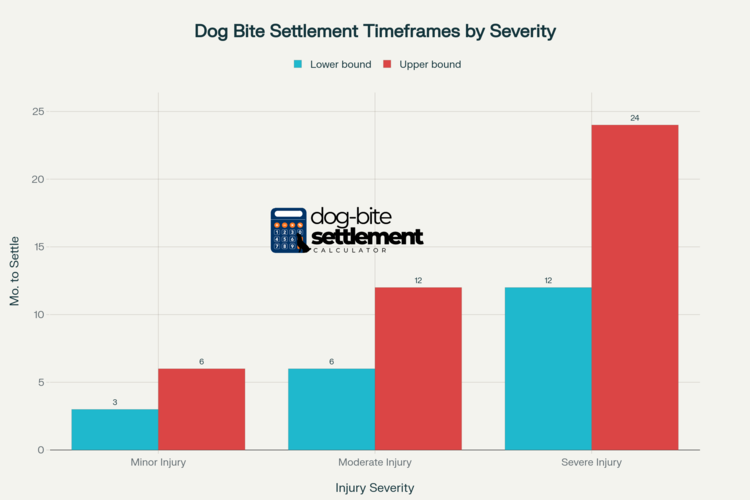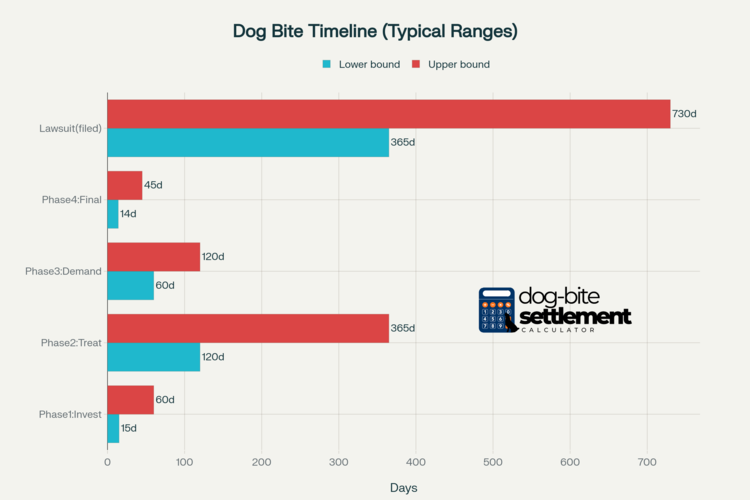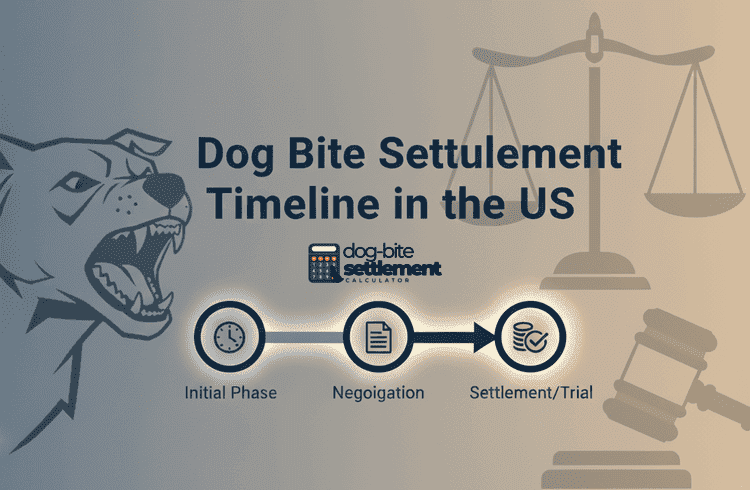Dog bite settlements in the United States take from two months to about a year for the final settlement. On average, it takes 405 days (13.5 months), as per law firms like Brown & Crouppen, MKP Law Group, Skinner and John Foy. After paperwork is signed, insurers typically issue funds in about 30 days. In case of minors, the disbursement extend to roughly two(02) to four(04) months for court approval. The compensation timeline varies from case to case and depends on medical stabilization or Maximum Medical Improvement (MMI), a complete demand package, insurer responsiveness, and court calendars.
This article is a comprehensive analysis of the time required to settle dog bite claims in the US. It is based on recent 2025 data from legal experts, insurance industry reports, and case studies from law firms across the United States to provide a realistic timeline.
How Long Does It Take for a Dog Bite Settlement?
Dog bite settlement follows a structured progression. The total duration is a sum of its distinct phases, each with a typical time frame. Our analysis of case data from various legal sources, including Rosenfeld Injury Lawyers and Zinda Law Group, reveals a comprehensive timeline that victims can anticipate.
The timeline settlement against dog bite is assessed at various levels in the sections below, which include:
- Timelines based on Type of Injury
- Timelines based on the State
- Timeframes in each Phase of the Claim settlement
The Settlement Timeline based on Injury Types

An outline of the general framework for the different types of dog bite cases is mentioned below:
- Severe Injury (e.g., reconstructive surgery, nerve damage, significant scarring, psychological trauma): Severe injury claim settlements take 12-24+ months, i.e 1-2 years. These complex cases require a long healing period to reach MMI and often involve filing a lawsuit to secure a fair settlement from a resistant insurance company.
- Moderate Injury (e.g., deep lacerations, stitches, minor scarring): Moderate injuries take 6-12 months for settlement. The timeline is extended by the need for more extensive treatment and follow-up care to determine the full extent of scarring.
- Minor Injury (e.g., scratches, minor puncture requiring no stitches): Minor injuries are fast settled in 3-6 months. These cases often involve minimal medical treatment and clear liability, allowing for a faster negotiation process.
Phase-Wise Timeline

This timeline represents the typical pre-suit settlement process, where a resolution is reached without filing a formal lawsuit.
Phase 1: Initial Investigation & Evidence Gathering (15-60 Days)
The initial investigation and evidence gathering immediately after the dog bite lay the groundwork for your entire claim. These initial actions create the official record and preserve the evidence necessary to prove your case.
Immediately following the incident, your attorney will gather police reports, interview witnesses, document the scene, and send a letter of representation to the dog owner’s insurance company. This phase is about establishing the foundational facts of your claim.
A broad overview of the timeline in this situation is summarized below:
- First 24–48 hours: You must report the dog bite to the appropriate local authorities, such as your city’s animal control agency or the police department. The timeline begins with the immediate documentation of the scene, identification of the owner, and formal reporting. These early reports should log date, time, location, owner identity, vaccination status, and any prior bite history.
- First 1–3 weeks: The insurance claim will be opened. The carrier initiates its liability and coverage review. It requests records like statements and photographs. The verification of homeowner’s or renter’s insurance coverage also happens in this timeframe.
- Weeks 2–8: It’s at this time that the counsel gathers medical records, witness statements, photographs, prior bite history, and sends notice of representation to the insurer.
Phase 2: Medical Treatment and Reaching Maximum Medical Improvement (MMI) (4-12 Months)
This phase is almost always the longest and most unpredictable part of the dog bite settlement timeline. You will undergo all necessary medical treatment to heal. Recovery spans four weeks to twelve months, depending on procedures, follow‑ups, and any scar‑revision or therapy plans tied to the clinical course.
The timeline concludes only when you reach Maximum Medical Improvement (MMI). As legal experts at Morgan & Morgan emphasize, settling before MMI is a critical error, as the full value of future medical needs would be unknown.
What Exactly is MMI and Why Does It Control Your Timeline?
Maximum Medical Improvement (MMI) is the point at which your medical condition has stabilized, and further improvement is unlikely. It does not mean you are fully recovered, but rather that your long-term prognosis is clear. It’s only after you reach MMI that your attorney can accurately calculate dog bite settlement damages, including:
- Past Medical Bills: All costs for ER visits, hospital stays, surgeries, and medication.
- Future Medical Costs: The projected cost of future care, such as scar revision surgery, physical therapy, or pain management.
- Lost Wages and Earning Capacity: Income lost during recovery and any long-term impact on your ability to work.
- Pain and Suffering: Compensation for the physical pain, emotional distress, and diminished quality of life resulting from the attack.
Settling before reaching MMI is a catastrophic mistake. If you later discover you need another surgery or ongoing therapy, you cannot go back and ask for more money.
Phase 3: The Demand and Insurance Negotiations (60-120 Days)
Once you reach MMI, your attorney calculates all your damages. They compile a detailed demand package with medical records, bills, and proof of lost income, sending it to the insurance adjuster. The insurer typically takes 30-45 days to review and make an initial offer. This offer is often very low, and the subsequent negotiation can last another 30-60 days.
The duration of this phase depends on the complexity of the case and the insurance company’s willingness to negotiate in good faith.
Phase 4: Finalizing the Settlement (14-45 Days):
After a settlement amount is agreed upon, the victim will sign a release agreement. From that point, it typically takes the insurance company 14 to 45 days to issue the settlement check to your attorney. The attorney then resolves any medical liens before disbursing the final funds to you.
Settlement vs. Lawsuit
The vast majority of dog bite cases, i.e over 95% are resolved through a settlement or pre-suit. However, when the insurance company refuses to make a fair offer, filing a lawsuit may be the only way. This action moves the case from the private negotiation realm into the public court system, which dramatically alters the timeline.
Lawsuit Settlement Timeline is typically 2-3 years. As noted by numerous legal experts, once a lawsuit is filed, the case is subject to court schedules, mandatory discovery processes, depositions, and pre-trial motions, adding at least a year or more to the resolution from the filing date.
Here is a consolidated, stage‑wise timeline table comparing as reported by multiple U.S. legal sources; the rightmost column lists each step, and the other columns show what each source reports for that stage.
Timeline From State to State
State law is a major factor in deciding the compensation timeframe. The legal doctrine governing dog bites in your state dictates the burden of proof, directly impacting the investigation timeline.
Example 1: California (A Strict Liability State)
In California, under Civil Code § 3342, a dog owner is strictly liable for damages if their dog bites someone on public property or lawfully on private property. You do not need to prove the owner knew the dog was dangerous. This simplifies the liability portion of the claim, often shortening the investigation phase and leading to a settlement timeline closer to the 9-14 month average.
Example 2: Texas (A “One-Bite Rule” State)
Texas follows the “one-bite rule.” To win a settlement, you must prove the owner knew (or should have known) their dog had acted aggressively or bitten someone before. This requires a more intensive investigation to find prior reports, interview neighbors, or uncover evidence of negligence, potentially extending the pre-negotiation phase by several months and pushing the timeline toward 15-24 months.
Current Timeline in 2025
As of 2025, victims should be aware of a few key trends impacting settlement timelines. Many court systems across the U.S. are still working through backlogs created in recent years, meaning the delay caused by filing a lawsuit is more significant than ever. Furthermore, with the average claim value rising, insurance companies are investing more resources into fighting claims, potentially prolonging the negotiation phase.
As reported by the Insurance Information Institute using State Farm claim data, U.S. dog‑related injury payouts totaled about $1.57 billion in 2024, with the average cost per claim near $69,272, trends that continue to shape negotiation ranges and insurer reserving in 2025.
As summarized in the III’s topical spotlight, claim frequency and severity remain elevated, which can stiffen early counters yet also support higher ultimate settlements once damages are fully documented and policy limits are verified
Why the Dog Bite Settlement Timeline Varies
The dog bite settlement timeline varies a lot based on 3 key factors:
- Severity of the Injury: A minor bite requiring only stitches may settle in under a year. A catastrophic injury requiring reconstructive surgery will take much longer because the MMI date is further out. Insurers heavily scrutinize high-value claims. According to the Insurance Information Institute (Triple-I), the average cost per dog bite claim soared to $64,555 in 2022, compelling insurers to contest severe injury cases more rigorously.
- Clarity of Liability: If the dog owner’s fault is undeniable (e.g., the dog was off-leash in violation of local ordinances), the claim moves faster. If the insurer argues you provoked the dog or were trespassing, the investigation phase will be significantly prolonged.
- The Insurance Company: Some insurance carriers are known for “deny, delay, defend” tactics, intentionally dragging out the process to pressure victims into accepting a lower settlement.
How to Speed Up the Settlement Process
While medical recovery cannot be rushed, several evidence‑driven actions can compress a dog‑bite claim’s lifecycle by reducing disputes, shortening insurer review cycles, and avoiding last‑mile funding delays. To speed up the claim settlement process, victims can follow these four steps:
Report the incident immediately
Prompt reporting to animal control or law enforcement creates a third‑party record with interviews, location details, and any prior complaints about the dog. As per multiple legal firms, animal‑control reports can motivate insurers to resolve claims rather than litigate when the file shows regulatory violations or documented prior aggression. Early reporting also helps the plaintiff’s investigation by preserving witness details and photographs during the first weeks when evidence is freshest.
Follow medical advice precisely
Since the recovery phase is the main factor that decides the settlement time period, consistent treatment is key. It will help the victim to reach maximum medical improvement soon. Skinner and MKP warn that settling before MMI risks undervaluing revision procedures or therapy, which can force additional negotiation rounds that add months compared with sending a complete, final medical package once care stabilizes.
Keep meticulous records
Insurers move faster when the victim has all the bills, medical records, wage‑loss proofs, photos, and a clear liability theory tied to state law.
Well‑organized evidence not only speeds the first offer but also narrows counters, increasing the likelihood of a 1–3 month pre‑suit resolution described by national PI guidance when liability is clear and damages are fully supported.
Hire an experienced dog‑bite lawyer
Specialized counsel understands strict liability versus negligence rules across states, which directly affects how quickly liability is conceded and whether pre‑suit settlement is realistic. Experienced lawyers sequence the case to avoid wasted cycles and can leverage discovery to move stubborn carriers, aligning with litigation timelines and tactics.
Frequently Asked Questions (FAQ)
Dog bite settlements usually take several months to up to two years to resolve, with 405 days(13.5 months) an average from various data we have gathered. The timeline depends on factors such as the severity of the injury, length of medical treatment, the complexity of liability issues, and whether negotiations or litigation are required.
The factors affecting settlement timelines are:
1. injury severity: (more severe injuries require longer treatment and documentation),
2. liability disputes: (disagreements about fault prolong the process), and
3. insurance negotiations (some insurers delay or undervalue claims).
Cases requiring litigation can add months or years.
Insurance companies and courts prefer to wait until you reach maximum medical improvement (MMI) before finalizing a settlement. This ensures all medical damages—past and future—are accounted for. Settling too early can lead to insufficient compensation if you require additional treatment later.
Yes, cases that require litigation typically take longer to settle. Court schedules, discovery, motions, and trial preparation can add many months or even years to the timeline compared to cases resolved through negotiation or mediation.
Yes, minor injuries with clear liability sometimes settle within a few months. Quick settlements usually happen when medical treatment is complete, liability is undisputed, and the insurance company is cooperative.
The absolute fastest a dog bite case can settle is 4-6 months. This is a theoretical value considering it’s for a very minor injury with undisputed liability and a cooperative insurance company.
Yes, often. Settlements for minors require court approval to ensure the child’s interests are protected, a process that can add 2-3 months to the final phase after an agreement is reached. Further, the multiplier factor involved in children is higher and hence insurance companies tend to delay the process.
Yes, absolutely. If the owner has no homeowner’s or renter’s insurance, you may have to file a lawsuit directly against their personal assets. This is a more complex and typically longer process with no guarantee of settlement.
After you sign the final settlement and release documents, it typically takes between 14 and 45 days to receive the funds from your attorney after they have paid any medical liens or expenses.
In almost all cases, yes. The recovery and rehabilitation period following a surgery is essential for determining the permanent impact of the injury, which is a key component of your damages. This process naturally pushes the MMI date, and thus the settlement, beyond the one-year mark.

